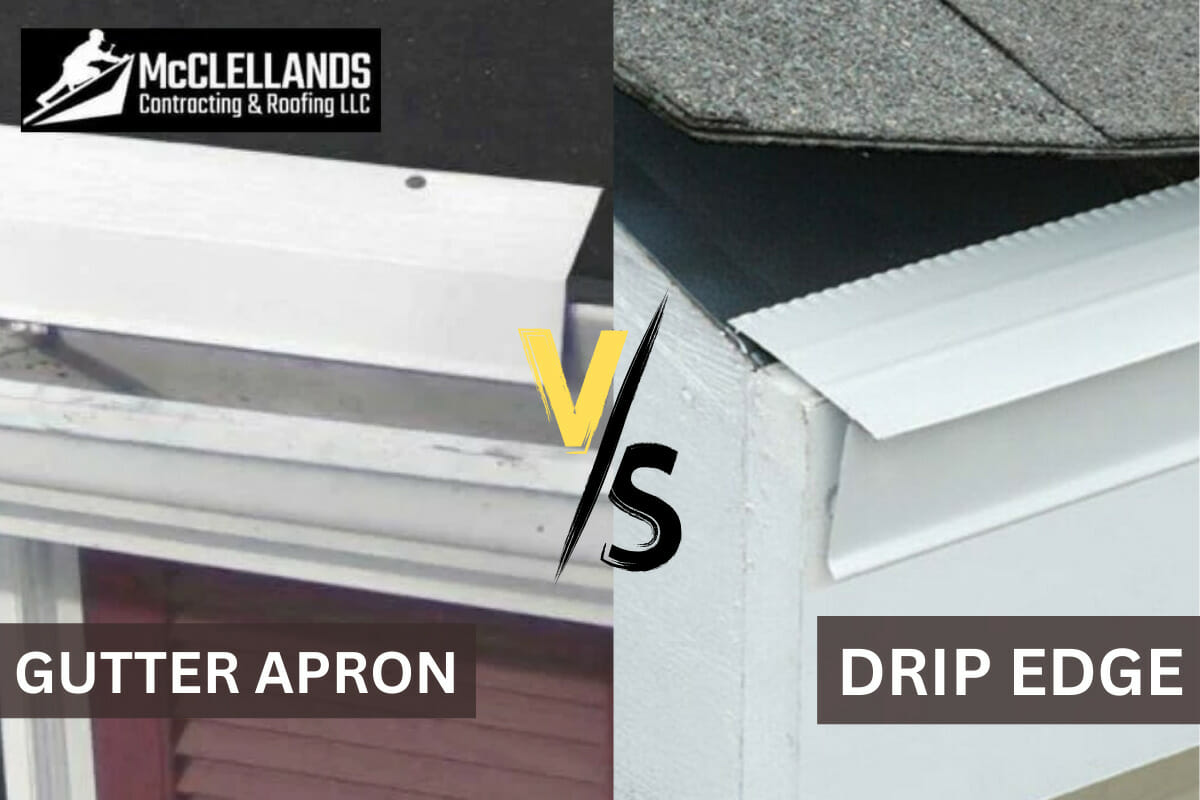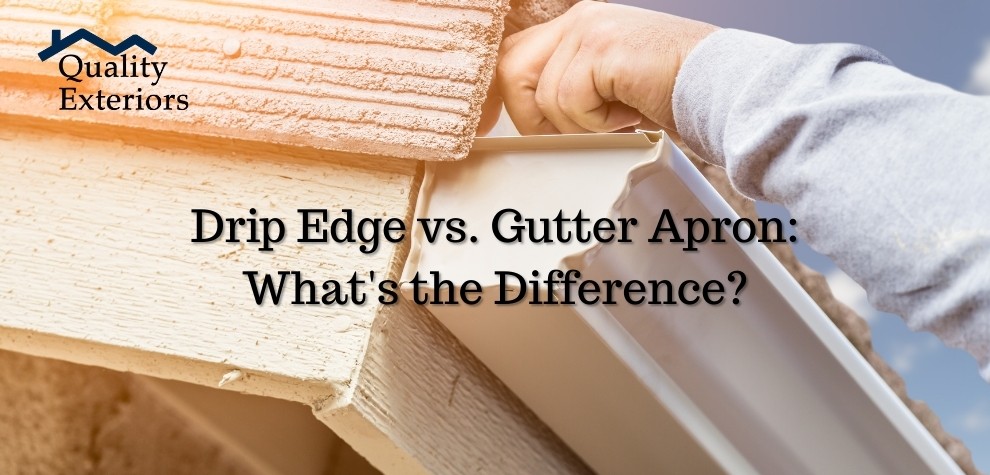Are you struggling to choose between a gutter apron and a drip edge for your home? It’s a common dilemma for homeowners looking to protect their roofs and foundations.
The right choice can save you from costly water damage, while the wrong one might lead to frustrating leaks and repairs. But don’t worry, you’re not alone in this. Understanding the differences and benefits of each option is crucial for making an informed decision.
This article will walk you through everything you need to know about gutter aprons and drip edges, helping you make the best choice for your home. Stick with us, and soon you’ll feel confident in protecting your investment. Let’s dive into the details together!

Credit: mcclellandsroofing.com
Gutter Apron Basics
Gutter aprons play a crucial role in protecting your home. They prevent water from seeping behind gutters. This ensures that the roof and walls remain dry. Understanding gutter aprons is essential for effective home maintenance.
Material Composition
Gutter aprons are often made from durable materials. Aluminum is a common choice due to its lightweight nature. It resists rust, making it long-lasting. Some aprons might use galvanized steel for extra strength. This material offers added durability against harsh weather.
Installation Process
Installing a gutter apron involves placing it under the roof shingles. The apron extends over the gutter. This guides water directly into the gutter system. Proper alignment is key to effective water flow. Installation may require professional assistance for best results.
Cost Considerations
Gutter aprons are generally affordable. The cost varies based on material choice. Aluminum aprons are usually less expensive. Galvanized steel ones might cost more due to their durability. Installation costs can add to the overall expense. Budgeting for both materials and labor is wise.

Credit: www.youtube.com
Drip Edge Essentials
Whether you’re a DIY enthusiast or hiring a professional, understanding drip edges is crucial for any roofing project. They protect your home by directing rainwater away from the roof and into the gutters. Without them, water can seep into your roof deck, leading to costly repairs.
Types Of Drip Edges
Drip edges come in various shapes and materials, each serving unique purposes. The most common type is the L-shaped drip edge, which is easy to install and fits snugly against the roof edge. Another popular option is the T-shaped drip edge, providing additional support to the shingles.
Aluminum is a favored material due to its durability and resistance to rust. Vinyl is also used, offering a more budget-friendly alternative, though it may not last as long. Consider your local climate and the specific needs of your home when choosing the type.
Installation Techniques
Proper installation ensures your drip edges function effectively. Begin by measuring the roof’s perimeter to determine how much material you need. Carefully align the drip edge flush with the roof deck before nailing it into place.
Use roofing nails to secure the drip edge, ensuring they are spaced evenly to prevent any gaps. A personal tip: always overlap the edges slightly to prevent water from seeping through. Have you ever wondered if a small oversight during installation could lead to bigger issues down the line?
Budget Implications
Cost is a critical factor when choosing drip edges. Aluminum edges may be pricier upfront but offer long-term savings due to their durability. Vinyl edges, while cheaper, might require more frequent replacements.
Factor in installation costs if you’re hiring help. A well-installed drip edge can save you money by preventing water damage. Balancing initial cost with potential savings is key. How do you prioritize your spending on essential home projects?
Incorporating drip edges into your roofing plan can protect your home from water damage and reduce future repair costs. By understanding the types, installation techniques, and budget implications, you can make informed decisions that safeguard your investment. Are you ready to make a choice that aligns with your needs and budget?
Comparative Analysis
In the world of roofing, understanding the differences between gutter aprons and drip edges is crucial. Both play significant roles in protecting your home from water damage. This comparative analysis explores their performance, durability, and maintenance needs. Discover which option might be best for your home.
Performance In Various Weather Conditions
Gutter aprons excel in rainy climates. They direct water effectively away from the roof edge. This prevents leaks and foundation damage. In snowy regions, drip edges perform well. They prevent ice dam formation by guiding melting snow safely. Each type offers unique benefits depending on weather conditions.
Durability And Longevity
Gutter aprons are made of strong materials. They resist rust and wear over time. This ensures a longer lifespan. Drip edges also offer durability but might need periodic checks. Their metal construction withstands harsh weather well. Choosing high-quality materials enhances longevity for both.
Maintenance Requirements
Gutter aprons demand regular cleaning. Leaves and debris can accumulate easily. This might block water flow if ignored. Drip edges require less frequent maintenance. Checking for damage and ensuring secure attachment is key. Proper upkeep ensures optimal performance of both systems.
Choosing The Right Option
Deciding between a gutter apron and a drip edge depends on your roofing needs. A gutter apron directs water into the gutter, preventing overflow. A drip edge protects the roof’s edges, ensuring water flows away efficiently. Both options help maintain roof integrity.
Choose based on your specific roof design and climate.
Choosing the right option between gutter apron and drip edge can significantly impact your home’s protection against water damage. These components play crucial roles in directing water away from your roof and foundation. But how do you decide which one is best suited for your needs? Understanding the specific features and applications of both can guide you to a decision that best fits your home’s requirements.Factors To Consider
When evaluating gutter apron versus drip edge, it’s essential to consider the climate in your area. If you live in a region with heavy rainfall, a gutter apron might be more beneficial as it provides a broader surface to channel water into the gutters effectively. Additionally, think about your roof’s design and the material used. Some roofing materials work better with a drip edge, which is typically easier to install and can enhance the aesthetic appeal of your roofline. Your budget also plays a crucial role. While both options are generally affordable, installation costs can vary depending on your roof’s structure and the complexity of the job.Expert Recommendations
Many roofing experts recommend using a combination of both a gutter apron and a drip edge for maximum protection. This approach ensures that any water that bypasses one component is caught by the other, reducing the risk of water damage. Professionals often suggest consulting with a roofing specialist to assess your specific situation. They can provide tailored advice based on years of experience and detailed knowledge of roofing systems. Consider scheduling an inspection to get an expert opinion on what would work best for your home. It’s a small investment that can save you from costly repairs in the future.Common Mistakes To Avoid
One common mistake is neglecting to check the compatibility of these components with your existing roofing system. Installing a gutter apron or drip edge that doesn’t align with your roof’s design can lead to inefficient water drainage and potential damage. Another oversight is ignoring maintenance. Regular inspections and cleaning are vital to ensure these components function correctly and last longer. Lastly, avoid opting for the cheapest materials without considering their durability. Quality matters when it comes to protecting your home, so always prioritize materials that offer longevity and reliability. Choosing between a gutter apron and a drip edge doesn’t have to be daunting. By considering these factors, seeking expert advice, and avoiding common pitfalls, you can make a well-informed decision. What are your priorities when selecting roofing components? Your choice today can safeguard your home for years to come.Enhancing Roof Protection
Choosing between gutter apron and drip edge can significantly impact roof protection. Gutter aprons shield the roof from water damage by directing runoff into the gutters, while drip edges prevent water from seeping under roofing materials, safeguarding the structure. Understanding their roles helps ensure effective roof maintenance.
Enhancing roof protection is crucial for maintaining the longevity and functionality of your home. Two key components to consider are the gutter apron and drip edge. Both play vital roles in directing water away from your roof and foundation, but how do they enhance your roof’s protection? Understanding their roles can help you make informed decisions for your home improvement projects.Additional Protective Measures
Considering additional protective measures is always a smart move. A gutter apron extends from the roof’s edge into the gutter. It acts as a barrier, preventing water from seeping under the shingles and causing damage. In contrast, a drip edge is installed along the roof’s edge to channel water into the gutter. It also protects the roof deck and fascia from water damage. Using both can significantly enhance your roof’s defense against water infiltration.Integration With Other Roofing Components
How well do your gutter apron and drip edge integrate with other roofing components? A seamless fit is essential for optimal performance. The gutter apron works well with roof underlayment, forming a protective layer that resists water intrusion. Similarly, drip edges are designed to complement shingles and flashing, ensuring a cohesive system that efficiently manages water runoff. Are all components in harmony on your roof?Long-term Benefits
Investing in a gutter apron and drip edge offers long-term benefits that can save you money. By preventing water damage, they help you avoid costly repairs to your roof and home’s structure. With these components, your roof is more resilient against harsh weather conditions. This added durability can enhance your home’s value and appeal. Are you ready to protect your home for the long haul? Consider these insights and think about your current roof setup. Are you maximizing its protection potential? Making these improvements might just be the peace of mind you’re looking for.
Credit: www.qeiroof.com
Frequently Asked Questions
What Is The Main Function Of A Gutter Apron?
A gutter apron directs rainwater into the gutters. It prevents water from seeping under the shingles.
How Does A Drip Edge Protect Your Roof?
A drip edge prevents water from damaging the roof edge. It directs water away from the fascia.
Can I Use Both Gutter Apron And Drip Edge Together?
Yes, you can use both. This provides extra protection against water damage on your roof.
Which Is More Important, Gutter Apron Or Drip Edge?
Both are important. Gutter aprons prevent shingle damage, while drip edges protect the roof edge.
How Do I Choose Between Gutter Apron And Drip Edge?
Consider your roof design. Use gutter aprons for shingle protection and drip edges for roof edge security.
Conclusion
Choosing between a gutter apron and a drip edge depends on your needs. Both options protect your home from water damage. Gutter aprons work well for larger volumes of water. Drip edges offer better protection against leaks at roof edges.
Think about your roof’s design and climate. Consider professional advice for the best choice. Proper installation is crucial for effectiveness. Regular maintenance ensures long-term protection. Understanding each option helps make a smart decision. Your home’s safety is worth the investment.
Make the right choice for peace of mind.




